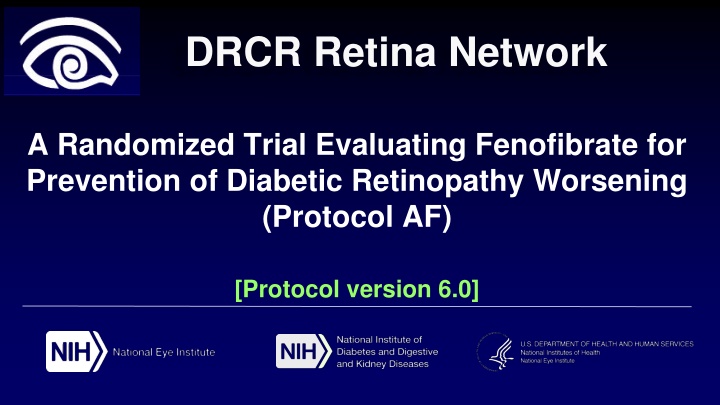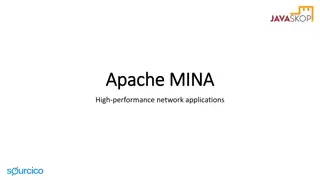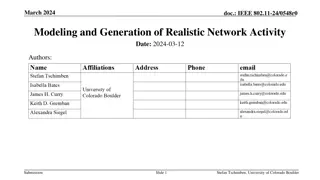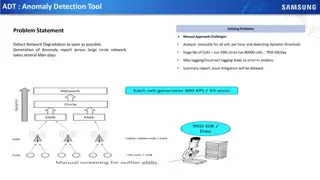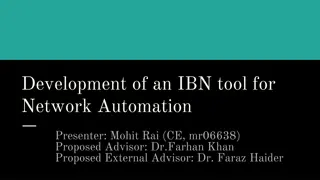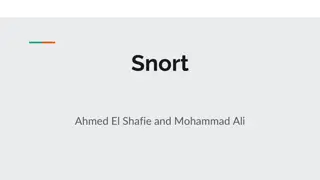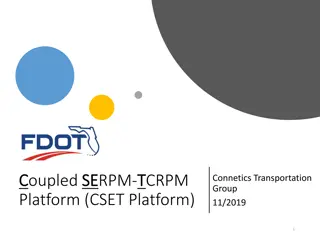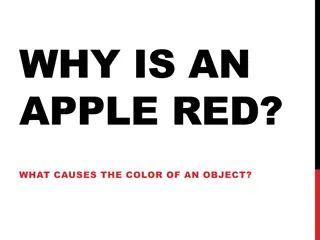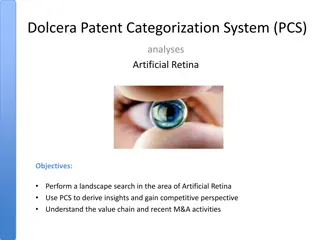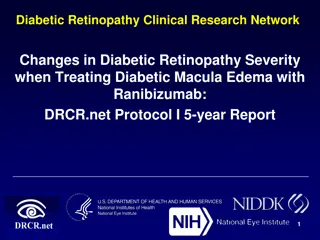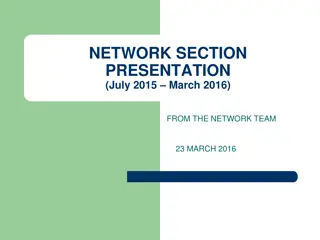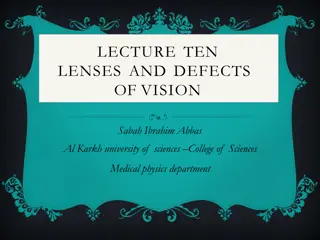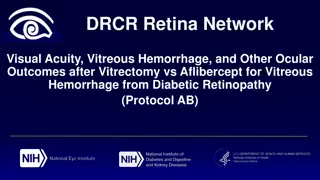DRCR Retina Network
Widespread use of fenofibrate, an oral agent, may reduce vision-threatening complications and vision loss in diabetic retinopathy. Explore the history, safety data, and ongoing studies regarding the use of fenofibrate in preventing diabetic retinopathy worsening.
Uploaded on Feb 19, 2025 | 1 Views
Download Presentation

Please find below an Image/Link to download the presentation.
The content on the website is provided AS IS for your information and personal use only. It may not be sold, licensed, or shared on other websites without obtaining consent from the author.If you encounter any issues during the download, it is possible that the publisher has removed the file from their server.
You are allowed to download the files provided on this website for personal or commercial use, subject to the condition that they are used lawfully. All files are the property of their respective owners.
The content on the website is provided AS IS for your information and personal use only. It may not be sold, licensed, or shared on other websites without obtaining consent from the author.
E N D
Presentation Transcript
DRCR Retina Network A Randomized Trial Evaluating Fenofibrate for Prevention of Diabetic Retinopathy Worsening (Protocol AF) [Protocol version 6.0]
Study Rationale Widespread use of an oral agent, fenofibrate, that is effective at reducing worsening of DR might decrease the numbers of patients who develop vision-threatening complications and need to undergo invasive treatment Reduce vision loss from advanced DR Reduce complications/adverse events associated with invasive and expensive treatments Long term study will provide opportunities to evaluate new imaging, visual function tests, methods for DR detection 2
History of Fenofibrate Two placebo-controlled clinical trials (FIELD and ACCORD) demonstrated a beneficial effect of fenofibrate on diabetic retinopathy as part of pre-planned secondary analyses However, for various reasons, treatment with fenofibrate has not been adopted by retina or systemic care practitioners lack of information belief that data is not strong enough to change practice hesitation to use a systemic drug by ophthalmologists inability to successfully grade retinal disease by PCPs 3
ACCORD Eye and FIELD Study ACCORD* (N = 801) FIELD** (N = 193) Fenofibrate + statin Placebo + statin Fenofibrate Placebo DR Progression Rates: Pre-existing Retinopathy *3 Steps on ETDRS Severity Scale or PRP; **2-step DR Progression 5% 12% 3% 15%
Safety Data from Prior Studies Usually well tolerated but a variety of uncommon side effects can occur including allergies, nausea, muscle aches/pains Increased risk of elevated serum creatinine which reversed when the drug was stopped During the course of the ACCORD study, participants had their fenofibrate levels adjusted for decreased GFR, and ultimately no difference in incidence of renal disease was found 5
Lowering Events in Non-proliferative Retinopathy in Scotland (LENS) Study Primary objective is to evaluate effects of fenofibrate on progression to clinically significant diabetic retinopathy/maculopathy Currently recruiting, estimated completion August 2023 Limitations PIs involved are general medicine/cardiovascular/nutrition practitioners (not retina or ophthalmology) Follow-up involves using Scotland s registry (usual care exams/imaging), not standardized data collection 6
Fenofibrate And Microvascular Events in Type 1 Diabetes Eye (FAME 1 EYE) Primary objective is to evaluate effects of fenofibrate on 2 step progression (ETDRS) and progression to clinically significant diabetic retinopathy/maculopathy requiring Rx Recruiting since 2016, estimated completion of study 2025 Limitations PIs involved are Internists, cardiologists, endocrinologists, (not ophthalmologists or retinal specialists) Study conducted in Australian and international sites with multiple endpoints in eye, kidney, CVD & neuropathy,------ adding complexity 7
DRCR Retina Network Study Objectives To determine if fenofibrate is effective at preventing DR worsening in eyes with mild to moderate non-proliferative DR and no CI-DME at baseline through 4 years of follow-up If effective, additional goals of the study are 1. To provide a model for ophthalmologists to prescribe and/or collaborate with an internist to prescribe and monitor the drug safely 2. Disseminate standardized prescribing guidelines with the aim to encourage broader use 3. Collect information on potential predictive biomarkers via blood sampling, functional and structural testing as well as glucose level from continuous glucose monitoring (CGM) over course of DR progression. 8
Ancillary Ocular Components The following visual function and structural testing will be used to explore association and predication of DR progression: contrast sensitivity visual field (VF) testing OCTA Specific objectives include: 1. Quantification of VF and contrast sensitivity at baseline & evaluation of relationship with DR severity level 2. Identification of biomarkers on OCTA at baseline that are associated with retinopathy progression 3. Explore whether fenofibrate treatment has any effect on VF and/or contrast sensitivity (even if no difference in central vision) 9
Contrast Sensitivity Contrast sensitivity will be assessed using Adaptive Sensory Technology (AST) platform Contrast sensitivity is measured using a device that will obtain the full contrast sensitivity curve across a spectrum of spatial frequencies 30 devices will be available for placement at select sites based on past performance and recruitment potential Training will be provided by AST 10
Continuous Glucose Monitoring (CGM) Primary objective of the CGM sub-study is to evaluate the relationship between glycemic parameters (e.g., time in range [TIR]) with DR progression Preliminary data from DCCT fingerstick samples suggests an association between TIR and development or progression of DR (Beck, et al) Participants in this study will wear a CGM for 10 days following each 6M visit to provide prospective, longitudinal CGM data in a large cohort at risk of DR progression 11
Study Design Multi-Center Randomized Clinical Trial (560 Participants) Major Patient-level criteria: No contraindication to fenofibrate use, no severe renal disease (eGFR must be 45), no liver disease (defined via central lab values) At least 1 eye* that meets these criteria (according to the investigator, confirmed by RC grading): ETDRS DR severity level between 35 and 47 (mild NPDR to moderately severe NPDR) Best-corrected E-ETDRS VA letter score 74 No prior treatment for DME or DR (other than focal/grid laser, but must be > 12 months prior) No anticipated need for intravitreous anti-VEGF or PRP in the next 6 months No history of intravitreous anti-VEGF or corticosteroid treatment within the prior year No evidence of CI-DME (using standard DRCR OCT thresholds) * If only one eye is eligible, the non-study eye must have at least microaneurysms only (DR severity level 20). Non-study Eye: There is no upper limit in DR severity level, and no exclusion criteria based on prior treatment. Fenofibrate Placebo Primary Outcome: Proportion of eyes with DR worsening by 6 years 12
Study Design Schematic Primary outcome is worsening of DR through up to 6 years, defined by the following in a study eye: 2 or more step worsening on ETDRS DR severity on fundus photos Development of NV within 7- modified ETDRS fields on FA Intraocular procedure undertaken to treat DR; including PRP, intraocular anti- VEGF, corticosteroid, or vitrectomy Screening Visit Eligibility Confirmation (RC, Lab, and PCP) Randomization Fenofibrate Placebo 3-month visit 3-month visit Follow-Up Visits: q6 months, through 4 years Annually at years 5 & 6* Follow-Up Visits: q6 months, through 4 years Annually at years 5 & 6* * Participants will be in study from 4 to up to 6 years, dependent on when the pt is enrolled and their level of DR at 4 years Follow-Up Phone calls 3 months after each visit Quarterly after 48-month visit Follow-Up Phone calls 3 months after each visit Quarterly after 48-month visit 13
Monitoring Systemic Safety How will liver and kidney functions be monitored in the trial? Urine/blood labs run at baseline and each follow-up visit and sent to the PCP. Participants with eGFR > 60 at screening will be on 160 mg dose Participants with eGFR 45-59 at screening will be on reduced 54 mg dose Protocol criteria for stopping or titrating a participant s treatment based on follow-up lab testing and safety evaluations. A central panel of internists will also be consulted during the study as needed. A summary of how often the pre-specified safety protocol was used and how often the panel was consulted will be reported with the study results. 14
Baseline Procedures Screening Visit VA (can be usual care) SD OCT (including RNFL) Ocular exam Fundus photos and FA, using widest field Blood pressure Urine sample Fasting blood sample Biomarker serum sample* RNA sample* Eligibility Confirmation Reading Center Central Lab PCP Randomization (within 60 days of screening visit) Protocol refraction/VA Ocular exam Blood pressure OCT Angiography* Visual Field* Eligibility will be confirmed via lab results and RC grading of DR severity level. Approval to participate in the study must be obtained from the participant s health care provider responsible for primary systemic management (e.g., endocrinologist or primary care provider) prior to scheduling randomization *Ancillary component at select sites/select participants 15
Treatment Regimen All participants will begin with a dose of either 160 mg or 54 mg Fenofibrate or placebo (determined by eGFR), taken orally once daily. Masked study drug should be administered with food, recommended with the morning meal. Since bile acid binding resins may bind other drugs given concurrently, patient should take study drug at least 1 hour before or 4 6 hours after to avoid impeding absorption. The initial 3-month supply will be provided at day of randomization. Thereafter study drug supply will be provided at each subsequent follow-up visit. 16
Follow-Up Annual Visits (through 4 years) 5 & 6 Year Visits 6-Month Interval Visits 3-Month Visit (to assess early systemic effects) Refraction/VA SD OCT (w/RNFL) Photos and FA, using widest field Ocular exam Blood pressure Urine sample Blood sample Systemic Safety Assessment CGM insertion OCTA Contrast sensitivity** HVF 30-2 & 60-4** Refraction/VA SD OCT (w/RNFL) Photos and FA, using widest field Ocular exam Blood pressure Urine sample Blood sample Systemic Safety Assessment CGM insertion Contrast sensitivity** HVF 60-4** Refraction/VA SD OCT (w/RNFL) Ocular exam Blood pressure* Urine sample * Blood sample* Systemic Safety Assessment CGM insertion OCTA** HVF 30-2** Blood pressure Urine sample Blood sample Systemic Safety Assessment *Only at FIRST 6-month visit; urine sample if needed for pregnancy **Ancillary component at select sites/select participants, only in the study eye(s) except for the final visit 17
Dose Titration Schedule Laboratory results will be obtained at select follow-up visits and will be sent to PCP and/or endocrinologist. If any values necessitate further action, an automatic email will be sent to the site prompting dose review ALT >3x ULN CK >5x ULN >50% reduction HDL Confirm with PCP no other cause Discontinue dose eGFR <30 Confirmatory blood draw within 4 weeks Confirm with PCP no other cause Discontinue dose eGFR 30 to <60 Confirm with PCP no other cause Cut dose in half 18
Communication with PCP One of the main objectives of this study is to develop a model for retina specialists and PCPs to work together to prescribe and monitor fenofibrate. All central laboratory values will be provided to the participant s PCP (sent from CC but site will have access). If the PCP recommends a change to study treatment that was not indicated per protocol, a central panel of internists will be consulted first if possible. If at any time the clinical site becomes aware of an elevated value from a usual care blood draw, the participant will be asked to obtain a confirmatory blood draw using the central laboratory. Dose-titrations will be made accordingly using central laboratory value. This Photo by Unknown Author is licensed under CC BY-SA-NC 19
DME Treatment Criteria for a Study Eye Study eye treatment for CI-DME must not be given until following criteria have been met: CI-DME on clinical exam with 10% increase in central subfield thickness from baseline and either 1. At least 10-letter decrease in VA presumed to be from DME at single visit or 2. 5 to 9-letter decrease in VA presumed to be from DME at 2-consecutive visits, at least 21 days apart Investigator is responsible for determining if scans are of sufficient quality to obtain accurate CST for determination of outcome. If OCT has artifacts, boundary lines, or centration issues that may invalidate automatic measurement, OCT should be sent to central reading center for manual grading prior to initiating treatment. 20
PDR Treatment Criteria for a Study Eye Treatment for PDR in a study eye must not be given until one of the following criteria has been met: 1. Definite neovascularization of the angle or neovascular glaucoma is present 2. The eye has PDR with high-risk characteristics, defined as: NVD greater than standard photograph 10A (1/4 to 1/3-disc area), or Any NVD with pre-retinal or vitreous hemorrhage, or NVE greater than disc area with pre-retinal or vitreous hemorrhage 3. The eye has vitreous hemorrhage requiring treatment that is presumed to be from PDR 4. In the absence of the criteria above, the Reading Center has confirmed NV is present and protocol chair approval has been received Note: Treatment for NPDR in the absence of CI-DME should not be given. 21
Treatment Initiation Study Eye If treatment is planned for a study eye at a non-annual or unscheduled visit, study procedures required at annual visits should be completed before treatment is administered. Once criteria for either DME or PDR has been met, treatment is at investigator discretion. However, if anti-VEGF is indicated, then study-provided ranibizumab should be given. Fenofibrate and follow-up should be continued through the 4-year visit, even after providing treatment for DME or PDR. Non-study Eye Treatment of DR or DME is at investigator discretion. Study-provided ranibizumab may be used, based on availability. 22
Thank you 23
